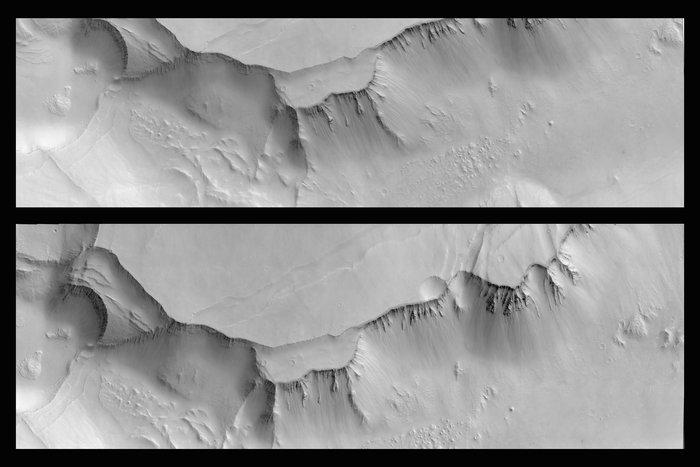http://www.esa.int/esl/ESA_in_your_country/Spain/Vision_en_estereo_de_Noctis_Labyrinthus
Visión en estéreo de Noctis Labyrinthus
14 marzo 2017
ExoMars salió de la base kazaja de Baikonur a bordo de un cohete Proton-N el 14 de marzo de 2016. Unos siete meses después, la nave llegó a Marte.
Como parte de los preparativos de su misión científica principal —analizar la atmósfera en busca de gases relacionados con actividad biológica o geológica, y los lugares donde se encuentran esas fuentes de gases— el Satélite para el estudio de Gases Traza (TGO) ha llevado a cabo dos campañas para probar sus instrumentos científicos: una el pasado mes de noviembre y otra la semana pasada.
Aquí vemos uno de los primeros pares de imágenes tomados por la cámara de alta resolución del orbitador el día 22 de noviembre.
Las imágenes superior e inferior conforman un par estéreo que muestra parte de la región marciana de Noctis Labyrinthus. La cámara primero toma una fotografía apuntando ligeramente hacia delante (en este caso, la imagen inferior) y, a continuación, tras haber sobrevolado el área, rota para apuntar hacia atrás y tomar la segunda parte de la imagen (superior); así, se captura la misma región de la superficie desde dos ángulos distintos.
Al combinar este par de fotografías, se construye una imagen en 3D y se obtiene información sobre las alturas relativas de las formaciones en la superficie del planeta.
Las fotografías fueron tomadas con la idea de comprobar la temporización de la cámara a medida que el satélite sobrevuela la superficie, para optimizar así la reconstrucción de las imágenes estéreo. La semana pasada se llevaron a cabo pruebas adicionales para perfeccionar el proceso.
La región de Noctis Labyrinthus, o ‘Laberinto de la noche’, se encuentra en el límite occidental de Valles Marineris, el gran cañón del Sistema Solar, y comprende una vasta red de mesetas y simas. Se han observado deslizamientos de tierra en los flancos de sus pronunciadas pendientes.
Desde su llegada, el orbitador también ha realizado una serie de maniobras para cambiar su periodo orbital y su inclinación, y ya está listo para comenzar esta misma semana la fase de aerofrenado, que durará un año. En este proceso, aprovechará la atmósfera del planeta para ir decelerando gradualmente hasta llegar a una órbita casi circular a 400 km de Marte, desde donde llevará a cabo la misión científica principal.
Las imágenes se tomaron con la cámara CaSSIS, a una escala de 7,2 m/píxel, y abarcan un área de Marte de unos 15 x 45 km.
English Versión :

- Title Noctis Labyrinthus stereo pair
- Released 13/03/2017 4:00 pm
- Copyright ESA/Roscosmos/CaSSIS, CC BY-SA 3.0 IGO
- DescriptionExoMars was launched on a Proton-M rocket from Baikonur, Kazakhstan on 14 March 2016. Around seven months later, it arrived at Mars.As part of preparations for its main science mission to analyse the atmosphere for gases that may be related to biological or geological activity, and image sites that might be related to these sources, the Trace Gas Orbiter has conducted two campaigns to test its science instruments – one last November and one last week.Presented here is one of the first image pairs taken by the orbiter’s high-resolution camera on 22 November.The images together form a stereo pair of part of the Noctis Labyrinthus region of Mars. The camera takes one image looking slightly forwards (bottom image in this orientation), and then, after having flown over the area, it rotates to look ‘back’ to take the second part of the image (top), in order to see the same region of the surface from two different angles.By combining the image pair, a 3D image can be constructed and information about the relative heights of the surface features can be seen.The images were taken to test the timing of the images as the spacecraft moves over the surface, in order to best reconstruct the stereo images. Additional tests were conducted last week to fine-tune the process.Noctis Labyrinthus, or ‘Labyrinth of the night’, lies on the western edge of Valles Marineris, the grand canyon of the Solar System, and comprises a vast network of flat-topped plateaus and trenches. Landslides are seen in the flanks of the steep slopes.Since arriving, the orbiter has also conducted a number of manoeuvres to change its orbital period and inclination, ready to begin the year-long aerobraking phase later this week. This process will use the planet’s atmosphere to gradually slow the spacecraft speed and so move it into a 400 km near-circular orbit, from which the craft will conduct its main science mission.The images were taken by the CaSSIS camera; the scale here is 7.2 m/pixel and the images correspond to an area on Mars about 15 x 45 km.
- Id 374513
- Click on the tags to find the matching images.
- Activity Space Science
- Mission ExoMars
- Set Space Science image of the week
Guillermo Gonzalo Sánchez Achutegui
ayabaca@gmail.com
ayabaca@hotmail.com
ayabaca@yahoo.com


No hay comentarios:
Publicar un comentario